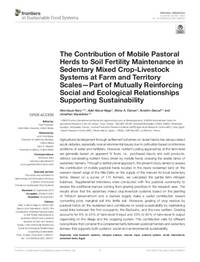The Contribution of Mobile Pastoral Herds to Soil Fertility Maintenance in Sedentary Mixed Crop-Livestock Systems at Farm and Territory Scales—Part of Mutually Reinforcing Social and Ecological Relationships Supporting Sustainability

Authors:
Agricultural development through settlement schemes on desert lands has always raised
acute debates, especially over environmental issues due to cultivation based on intensive
additions of water and fertilizers. However, nutrient cycling approaches at the farm level
are generally based on apparent N flows, i.e., purchased inputs and sold products,
without considering nutrient flows driven by mobile herds crossing the arable lands of
sedentary farmers. Through a territory level approach, the present study aimed to assess
the contribution of mobile pastoral herds located in the newly reclaimed land on the
western desert edge of the Nile Delta on the supply of the manure for local sedentary
farms. Based on a survey of 175 farmers, we calculated the partial farm nitrogen
balances. Supplemental interviews were conducted with the pastoral community to
assess the additional manure coming from grazing practices in the research area. The
results show that the sedentary mixed crop-livestock systems based on the planting
of Trifolium alexandrinum and a manure supply make a useful contribution toward
converting poor, marginal soil into fertile soil. Moreover, grazing of crop residue by
pastoral herds on the reclaimed land contributes to social sustainability by maintaining
social links between the first occupants, the Bedouins, and the new settlers. Grazing
accounts for 9% to 34% of farm-level N input and 25% to 64% of farm-level N output
depending on the village and the cropping system. This contribution calls for different
rural policies that consider the complementarity between pastoral herders and sedentary
farmers that supports both systems’ social and environmental sustainability.
